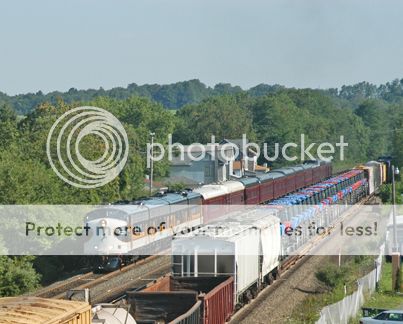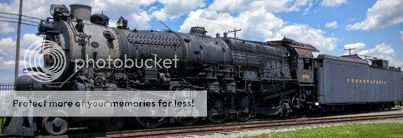Monthly Train-Calendar Report for March 2017

Amtrak’s eastbound Pennsylvanian passes a westbound stacker in Lilly, PA. (Photo by BobbaLew with Phil Faudi.)
—The March 2017 entry in my own calendar is Amtrak’s eastbound Pennsylvanian on Track Two, passing a westbound stacker on Track Three.
We are on an overpass in Lilly, PA.
It’s the only picture in this 2017 calendar where Phil Faudi (“FOW-dee;” as in “wow”) was with me.
Phil is my railfan friend in Altoona who introduced me to many of the fabulous photo locations around Allegheny Mountain.
He did it as a business at first. Taking his railroad-radio scanner, along with his vast knowledge of schedules and area operations, he’d zag me all over the mountain “chasing” trains.
He called ‘em “tours.”
Railfan overload; I’ve been one since age-2.
We’d be motoring placidly along, he’d hear something on his scanner, and suddenly we’d do a 180° turn.
Every time a train passes a signal, its engineer has to report the signal-aspect on railroad-radio: e.g. “04T, east on Two, 258.8; CLEAR!”
04T is Amtrak’s eastbound Pennsylvanian.
Phil knew where the signal at milepost 258.8 was, and now I do.
Can we get to that overpass in Lilly before 04T?
The chase begins!
I remember bucketing down a one-lane dirt-track, parting shrubbery with Phil’s Buick. “I hope no one’s coming,” he said.
The Pennsylvanian is the only passenger-train left on this storied line.
04T is eastbound (in the morning), and 07T is westbound (late afternoon).
The picture is long ago = six or seven years, maybe even eight.
My wife was still alive, and Phil was still in business.
He has since given it up. His wife has Multiple Sclerosis, and he wants to be around in case she falls.
In fact, he gave up the business years ago, but continued leading me around, me driving instead of him.
Now he just stays home, but monitors his railroad-radio scanner and calls my cellphone.
Now it’s just me and my brother Jack from Boston. Both Jack and I became fairly savvy with our railroad-radio scanners — Jack more than me. Often my brother shouts “call Faudi!”
It’s March. Spring is coming, and snow is melting.
Light is still low, but we beat 04T to Lilly.
Phil stops atop the bridge to let me out.
A westbound stacker is passing underneath on Track Three.
Here it comes! I’m gonna get what Phil calls a “double,” two trains at once.
BAM!

Not the ore-train. (Photo by Robert Malinoski.)
—The March 2017 entry in my All-Pennsy color calendar is two Pennsy I-1 Decapods (2-10-0) leading a coal-train near Tharptown, PA.
I can’t find Tharptown in my GoogleMaps, but a village of sorts is just north of Shamokin (PA) and has a “Tharp” Street.
The railroad runs through it, and Shamokin Creek is in the foreground of the picture.
The caption says two more Deks were pushing.
The Deks were 10-drivered Consolidations (2-8-0), what Pennsy earlier used to move its freight — especially in mountainous PA.
The Deks were developed after 1916, and were so big enginemen called ‘em “Hippos” — big for that time; bigger engines came later.
Pennsy’s Dek was difficult, crews hated ‘em.
With drivers so small, 62 inches in diameter, counterbalancing heavy side-rod weight was near impossible. Therefore they rode rough, slamming the crew up-and-down.
50 mph was about all they could do, if you could stand it.
But they were immensely powerful.
They also were the first Pennsy engines with coal-stokers. Even two firemen couldn’t keep up with a Dek’s coal demand.
 |
| The last remaining Pennsy Dek, shorn of its boiler-lagging and piston-rods, stored inoperable near Buffalo. (Photo by Chris Galka©.) |
Four Deks, two pushing, would slam a heavy train of iron-ore up Pennsy’s Mt. Carmel branch to interchange with Lehigh Valley. The ore was for Bethlehem Steel.
4483 came from another final stomping-ground for Pennsy’s Deks: heavy coal trains up Pennsy’s line across NY to Sodus Point wharf on Lake Ontario.
Pennsy saved 4483, originally with its collection of venerable steamers at Northumberland roundhouse.
Most of those streamers are now at Railroad Museum of Pennsylvania near Strasburg, PA.
Thank goodness Pennsy saved one of each class of its classic locomotives = those actually owned by Pennsy, not some investment trust. Most railroads scrapped their retired steamers.
But 4483 was moved to Wilmerding, PA for display in front of the Westinghouse Plant.
4483 has since been moved again, and is now stored near Buffalo, NY.
Pennsy didn’t save any of its modern steamers, like the gigantic Qs and T-1 duplexes. (The Qs were also duplex.)
But the train is using four Deks, just like a Mt. Carmel ore-train.
It’s heavy, and probably headed for Mt. Carmel, where it will become like a Mt. Carmel ore-train.

Probably 36A. (Photo by Sam Wheland.)
—The March 2017 entry in my Norfolk Southern Employees’ Photography-Contest calendar is a trainload of farm-equipment passing CP-Hunt on the old Pennsy main across the state.
My guess is it’s 36A, the first train I saw with my railfan friend Phil Faudi many years ago.
Phil was conducting railfan “tours” in the Altoona area as a business at that time. It was our first “tour.”

The “Tuxedos” behind 36A. (Photo by BobbaLew with Phil Faudi.)
Phil showed at my bed-and-breakfast and exhorted me to quickly get in his car. I was alone.
Norfolk Southern’s Executive Business-Train was climbing The Hill. Our goal was to photograph it; we quickly zoomed toward Lilly.
An overpass was over Pennsy’s tracks — same overpass as my first picture — so we parked, got out, and walked up on the bridge.
Train 36A was passing underneath; it had farm equipment loaded on flatcars.
36A was eastbound on Track One. The Executive Business-Train would be westbound on Three.
At that hour you have to be east of the tracks to get proper sunlight. Therefore 36A could block the Executive Business-Train.
Norfolk Southern’s Executive Business-Train uses four rebuilt EMD F cab-units, both A and B, for power.
The train itself is restored passenger equipment, usually in Norfolk Southern or Norfolk & Western tuscan-red paint (“TUSS-kin;” not “Tucson, Ariz.”).
The F-units are painted dark brown with white trim, and called the “Tuxedos.”
I thought 36A was gonna block, but two gondolas appeared which allowed me to photograph.
Phil told me 36A often has farm equipment, bull-dozers, etc.
My first thought was 35A, but that ain’t right. Odd is westbound.
CP-Hunt is an interlocking in Huntingdon on the old Pennsy “Middle Division.”
The Middle Division, from Harrisburg to Altoona, is the original Pennsy main laid down during the early 1850s.
The railroad still follows the original alignment, but curves were eased, etc.
The line became so busy Pennsy had to go to three or four tracks, the “Broad Way.”
West of Tyrone there’s a controlled siding which renders three tracks into Altoona.
Now it’s mostly just two tracks west of Harrisburg, although on Allegheny Mountain, west of Altoona, three tracks are used — four at one point.
And I notice the train has only a single unit, an EMD SD60I.
SD60Is are ex-Conrail, only purchased by Conrail, and had a special quiet cab.
I heard the dispatcher refer to “one-unit wonders” on my Internet railroad-radio feed.

This time it is. (Photo by Robert F. Collins©.)
—This time it IS the Mt. Carmel ore-train, 60 hoppers loaded with heavy iron-ore for Bethlehem Steel.
But it’s not at Shamokin (PA) yet; it’s departing Northumberland Yard for Shamokin, where it will become the famous Mt. Carmel ore-train, headed up Pennsy’s torturous Mt. Carmel branch for interchange with Lehigh Valley in Mt. Carmel (PA).
In Shamokin it may switch to four Pennsy Decapods (2-10-0), two pulling and two pushing. But here it’s getting by with an M-1 Mountain (4-8-2), and perhaps a pusher. (I see smoke!)
Out of Northumberland is not as challenging as the Mt. Carmel branch.
The March 2017 entry of my Audio-Visual Designs black-and-white All-Pennsy Calendar is M-1 #6782 threading the twin bridges over the Susquehanna out of Northumberland on June 15, 1956.
In 1956 steam on Pennsy would last another year.
Pennsy considered the M1 Mountains the finest steam-engines they had. Mountains were excellent cruisers; 30-55 mph.
The M-1 Mountains were used to haul freight over Pennsy’s “Middle Division,” its original mainline across PA, Harrisburg to Altoona, through the end of steam in 1957.
Mountains were fabulous for the assignment. Steady uphill Harrisburg to Altoona, but not arduous. 40-50 mph average, sometimes faster. A river grade; the Juniata River (“june-eee-AT-uh).
Their firebox, at 70 square feet of grate, was same as a Decapod, and even the K-4 Pacific (4-6-2). But the boiler was that of the Decapod, and ahead of the firebox was a long open combustion-chamber.
It enhanced coal-burning.
It’s intriguing to consider a Pennsy 4-8-4 if they had developed one — the Mountain is only 4-8-2.
But Pennsy was pouring investment into electrification. Plus they could doublehead K-4s to cope with increased train weights.
They could afford double crewing. (Steam-locomotives couldn’t MU.)
A PRR 4-8-4 didn’t come until WWII, and that was duplex, the T-1 4-4-4-4.
T-1s weren’t articulated; its eight drivers were on a single frame with four drive-pistons.
Pennsy also had duplex freight steamers: the huge Qs (4-6-4-4 and 4-4-6-4).
None were saved; nor T-1s either.
Thankfully an M-1 was saved, #6755 at Railroad Museum of Pennsylvania near Strasburg (PA).

M-1 #6755, shorn of its boiler-lagging, subject to the weather — to me the most important Pennsy steamer extant. (Pennsy loved ‘em.)
It was one of engines Pennsy saved at Northumberland Roundhouse. One of a number of historic PRR steamers now at Railroad Museum of Pennsylvania.
None are currently operable, although a couple have been. They were operated on the short Strasburg tourist railroad in southeastern PA.
The M-1 was also more dual-purpose. Its drivers are only 72 inches diameter (six feet), not the 80 inches of a passenger engine (K-4s and E-6s [4-4-2] are 80 inch).
I did some poking around with Google Satellite-Views. It looks like Northumberland’s iconic twin bridges are gone.
The bridge at right looks oldest, and was the one removed. It could only handle one track.
The bridge at left remains, and was and still is (or was in the Satellite-View) double-track.
I don’t know what goes where down there. The calendar-caption says the train is headed for Shamokin. To me the light says the train is headed south, like perhaps down the Susquehanna on its east bank.
As I see it, the train is headed to the branch inland to Shamokin. That’s south of Northumberland.
Northumberland is where the Susquehanna breaks into west and north branches.
The twin bridges were to an island in the north branch. More bridging was needed to get off that island.
I also can’t imagine a Pennsy Mountain slugging that heavy ore-train up the Mt. Carmel branch.
It’s a dramatic picture, but confusing.
I also can’t help noticing that gorgeous slab-sided Belpaire (“bell-pear”) firebox, a trademark of nearly all Pennsy engines.
It was much longer than the grate to accommodate the combustion-chamber.
Labels: Monthly Train-Calendar Report



























